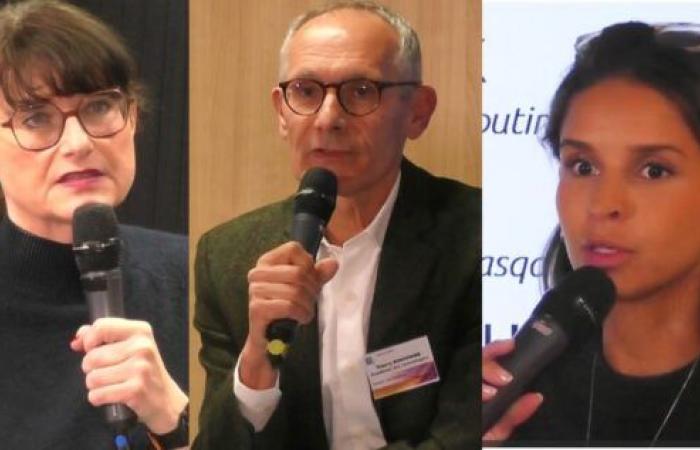
Under the leadership of Didier Carré, president of the G9+ institute, and hosted by Sopra Stéria, a conference was held at the end of November on the current and future situation of quantum computing in France and in Europe with results encouraging for the French sector.
Amandine Reix (far left in the photo), Deputy Director of Space, Electronics and Software at the General Directorate of Enterprises, recalled the commitment made in 2021 by the President of the Republic for the State to invest 1 billion ‘Euros of public money in the field of quantum computing through the France 2030 mission.
“This is an issue of sovereignty,” recalls Ms. Reix. “Quantum represents enormous challenges for the military, pharmaceutical, energy and meteorological fields, in particular.”
Madame Reix bluntly underlines the economic dimension of the discipline: “We can make money with it and that’s what we want to do.” She also invites private companies to also contribute significantly to the development of the quantum computer and specifies that French companies in the field have already raised 350 million euros.
Fanny Bouton, of OVH Cloud (second from left), quotes the company’s CEO Octave Klaba who estimates that any company with a turnover of 1 billion euros should invest at least 1 million € in quantum computing to prepare for the future.
Five startups selected
In its investments, the State has chosen five start-ups which each have different technological bets in order to cover a large part of the material realizations envisaged for the future and while remaining agnostic. The five companies are Quellela, Pasqal, Alice & Bob, C12 and Quobly. “It is not a technology that is completely mature at the moment, but our country is well positioned and we have every reason to hope.”
One caveat, however: to finance themselves, start-ups may be tempted to turn to non-European funds and the State specifies that it will be very attentive to this, always for its sovereignty requirements. For this reason, public authorities rely primarily on fundamental research in order to avoid, on the one hand, technology transfers to third or even hostile countries and, on the other hand, to allow the creation of an ecosystem supporting this work. Ms. Reix also highlights the need to secure materials such as silicon 28, cryogenics with large industrial groups like Air Liquide and to operate public procurement via Proqcima.
The Holy Grail of the FTQC
All the operations carried out by the different actors, independently of their technological choices, have a common objective: to achieve the FTQC (Fault Tolerant Quantum Computer), that is to say so-called “perfect” quantum computers. “.
A first report on the work of the technology academy led by Thierry Bonhomme (in the middle in the photo) has just been completed and will be revealed in the coming weeks.
“In broad terms, the report emphasizes scaling towards FTQC and the algorithm that must be associated with it,” underlines Mr. Bonhomme. “The report also highlights the resources needed around the different applications: nitrogen chemistry, drug chemistry, corrosion-resistant materials, Shor’s algorithm.
In this regard, Mr. Bonhomme also debunked a rumor that emerged a few weeks ago claiming that Chinese scientists had been able to crack the 2048-bit RSA encryption keys by implementing the aforementioned algorithm. What would have been a global explosion for the security of transactions is in reality only what the Anglo-Saxons call Fud for Fear, uncertainty and Doubt.
Indeed, it would be necessary to mobilize the equivalent of 10 to the power of 12 operations, which is strictly impossible currently in addition to 7000 logical qbits. In other words, it is not tomorrow that Shor’s algorithm will be able to be implemented. Mr. Bonhomme believes that the most optimistic forecasts showing a 5-year time frame are not realistic according to him.
Realistic roadmaps
One of the most encouraging points is that all of the past roadmaps have been maintained, which may suggest that future ones will also be, although there is uncertainty over which technology will prevail. However, Mr. Bonhomme does not deny the extent of the challenges before arriving at the FTQC. “I see four: Quality and quantity of Qbits, error correcting codes, the interconnection between the QPUs (Qantum Processing Unit) and finally the technical architecture and not just the processor and the latter is not developed enough In France “.
Chloé Poisbeau (second from the right), COO of Alice & Bob, talks about the company’s 2024 progress. “From the outset, we chose to have a roadmap focused on the FTQC. As a result, a significant part of our work focuses on the quality of Qbits. We focus on performance and quality in error correction before accumulating them. Recently the company put a 1 Qbit chip on the Google marketplace which is characterized by a very high error correction rate.
The company also offers a quantum emulator available through the operator Equinix. Alice & Bob’s technological choice is based on a technology called Qbits de chats, which considerably simplifies the all-important step of correction. Like the other players, the 2028-2030 horizon is mentioned as a minimum for arrival at the FTQC. Ms. Poisbeau indicates that it is from 100 logical Qbits that we start to see evidence that quantum computing outperforms traditional computing. To do this, it is necessary to create and stabilize a certain number of physical Qbits. The objective is therefore to obtain this power before the end of the decade with a precise roadmap which will be detailed at the end of this year.
Google recently published a study showing that the significant increase in Qbits had an impact on error correction, an essential step to achieve FTQC. “It’s a major publication that has had a lot of impact in the industry,” recalls Chloé Poisbeau. “Google says that to run Shor’s algorithm, they would need 20 million physical qbits. We (Alice & Bob) did the same study and we arrive at 200,000 physical qbits, because we use another technique for error correction.”
Pasqal and Quandela deliver solutions
As for Pasqal, we focus on 3 areas. The first is, unsurprisingly, the computer and the company very recently delivered a 100 Qbit machine to Germany. Another machine will be delivered to Saudi Arabia next year. “Very recently we managed to trap 1000 atoms, which means that in our technology, one trapped atom is equivalent to 1Qbit,” says Lina Alzate, sales manager for Pasqal.
The second axis is the software which is Open Source which is made available to users in order to start testing, access to the Microsoft Azure and Google cloud as well as a partnership with IBM for biology and materials science. Finally, the 3rde The main focus is to develop user cases so that clients can work concretely.
For Quandela, the year 2024 marked the start of their factory built the previous year and the first deliveries of quantum computers, notably for OVH in France and Canada.
“The first quantum computers we are delivering are for users to train, test and compare to what exists in traditional computing. We are committed to building an ecosystem around this discipline,” reveals Valerian Giesz (far right in the photo), co-founder and COO of Quellela. “Today we have more than 1,000 users on our cloud and we work with partners like OVH Cloud and Scaleway in order to create more and more use cases. »
The company says it has successfully developed photonic-corrected Qbits and now it is a matter of assembling them and scaling them up. Mr Giesz explains that photonics working with optical fibers means that these are low energy consumption models and that the photon being a relatively solid qbit, there is no need to cool it to very low temperatures . The first corrected quantum computers are planned for 2027.
Pasqal is working on his next machine called “Orion Beta” which should see the light of day before the end of the year. It will have 1000 qubits and will support around 5 million quantum gate operations. The “Orion Beta” machines can be ordered for “on-premises” installations at the end of 2024/beginning of 2025. At the same time, Pasqal should complete the successor called “Orion Gamma” in 2025 which will offer “ultra high fidelity” doors and will support up to ‘to 10 million operations. Finally, Pasqal is targeting 10,000 qubits by 2028 with a new scalable architecture with logical qubits thanks to a new quantum processor called Vela. With this machine, Pasqal hopes to improve repetition rates by 3 and support up to 40 million gate operations.
Pasqal’s roadmap does not stop there, however. Deeptech researchers are already imagining a Pegasus processor for 2027, still equipped with 10,000 qubits, but offering much greater algorithmic depth of up to 200 million operations.
Beyond that, Pasqal foresees a new quantum processor called Centaurus, their first QPU with integrated fault tolerance (therefore FTQC generation, Fault Tolerant Quantum Computing) this time offering 128 logical qubits (fruits of the combination of thousands of physical qubits) and 200 million quantum gate operations.
Software based on tensor networks
The Muliverse computing approach is software. Unlike hardware manufacturers, Multiverse relies on the mathematical formalism of tensor networks used for several years by physicists working on condensed matter. Tensor networks make it possible to capture most of the information in a quantum system in terms of superposition or entanglement on traditional computers. They are very fashionable today, because they allow us to push the limits of traditional computing. The company is now celebrating its 5th anniversary with 150 projects and 50 clients.
Some are pilot projects and others are in production. The company has also developed 2 libraries accessible to all for work on Machine learning and optimization in HPC. One of the company’s new products is called Singularity. This is a technology that significantly compresses LLMs through tensor networks.
Michel Kurek, CEO France of this company of Spanish origin, specifies: “we have established a partnership with Pasqal and IBM and by using IBM’s superconducting technology, we provide access to more than 120 qbit”. Singularity makes it possible to address questions around Deep learning, Machine learning and the optimization of AI models.
We can see it: the year which is ending has been rather fruitful and all those involved have great hopes for the years to come. Let’s hope they’re not wrong.





